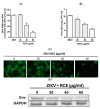In Vitro Antiviral Activity of Rhodiola crenulata Extract against Zika Virus and Japanese Encephalitis Virus: Viral Binding and Stability
- PMID: 39204093
- PMCID: PMC11357342
- DOI: 10.3390/ph17080988
In Vitro Antiviral Activity of Rhodiola crenulata Extract against Zika Virus and Japanese Encephalitis Virus: Viral Binding and Stability
Abstract
Zika virus (ZIKV) and Japanese encephalitis virus (JEV) can cause permanent neurological damage and death, yet no approved drugs exist for these infections. Rhodiola crenulate, an herb used in traditional Chinese medicine for its antioxidation and antifatigue properties, was studied for its antiviral activity against ZIKV and JEV in vitro. The cytotoxicity of Rhodiola crenulata extract (RCE) was evaluated using the CCK-8 reagent. Antiviral effects of RCE were assessed in ZIKV-infected or JEV-infected Vero cells via quantitative reverse transcription polymerase chain reaction (qRT-PCR), Western blotting, fluorescent focus assay (FFA), and immunofluorescence assay (IFA). The cell-free antiviral effects of RCE were evaluated using an inactivation assay. To determine the stage of the viral life cycle affected by RCE, time-of-addition, binding, and entry assays were conducted. Three bioactive constituents of RCE (salidroside, tyrosol, and gallic acid) were tested for antiviral activity. RCE exhibited dose-dependent anti-ZIKV and anti-JEV activities at non-cytotoxic concentrations, which were likely achieved by disrupting viral binding and stability. Gallic acid exhibited antiviral activity against ZIKV and JEV. Our findings indicate that RCE disrupts viral binding and stability, presenting a potential strategy to treat ZIKV and JEV infections.
Keywords: Japanese encephalitis virus; Rhodiola crenulata; Zika virus; antiviral agent; gallic acid; salidroside.
Conflict of interest statement
The authors declare no conflicts of interest.
Figures








Similar articles
-
Japanese encephalitis virus inhibits superinfection of Zika virus in cells by the NS2B protein.J Virol. 2024 Mar 19;98(3):e0185923. doi: 10.1128/jvi.01859-23. Epub 2024 Feb 27. J Virol. 2024. PMID: 38411948 Free PMC article.
-
The effects of Japanese encephalitis virus antibodies on Zika virus infection.Med Microbiol Immunol. 2020 Apr;209(2):177-188. doi: 10.1007/s00430-020-00658-2. Epub 2020 Feb 20. Med Microbiol Immunol. 2020. PMID: 32078028
-
Neuroprotective effects of a Rhodiola crenulata extract on amyloid-β peptides (Aβ1-42) -induced cognitive deficits in rat models of Alzheimer's disease.Phytomedicine. 2019 Apr;57:331-338. doi: 10.1016/j.phymed.2018.12.042. Epub 2018 Dec 31. Phytomedicine. 2019. PMID: 30807987
-
Antiviral activity of peptide inhibitors derived from the protein E stem against Japanese encephalitis and Zika viruses.Antiviral Res. 2017 May;141:140-149. doi: 10.1016/j.antiviral.2017.02.009. Epub 2017 Feb 21. Antiviral Res. 2017. PMID: 28232248
-
NS5 from Dengue Virus Serotype 2 Can Adopt a Conformation Analogous to That of Its Zika Virus and Japanese Encephalitis Virus Homologues.J Virol. 2019 Dec 12;94(1):e01294-19. doi: 10.1128/JVI.01294-19. Print 2019 Dec 12. J Virol. 2019. PMID: 31597763 Free PMC article.
References
-
- Pielnaa P., Al-Saadawe M., Saro A., Dama M.F., Zhou M., Huang Y., Huang J., Xia Z. Zika virus-spread, epidemiology, genome, transmission cycle, clinical manifestation, associated challenges, vaccine and antiviral drug development. Virology. 2020;543:34–42. doi: 10.1016/j.virol.2020.01.015. - DOI - PubMed
Grants and funding
LinkOut - more resources
Full Text Sources

